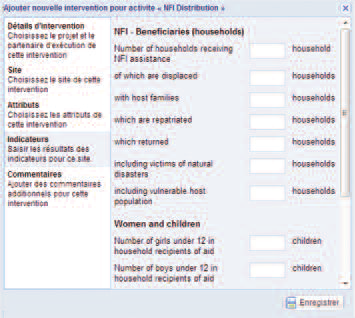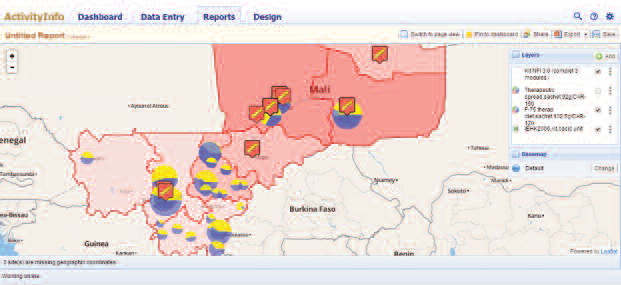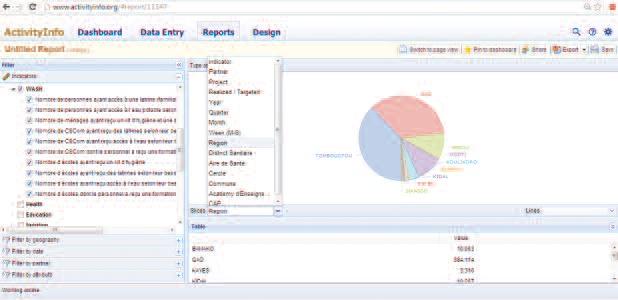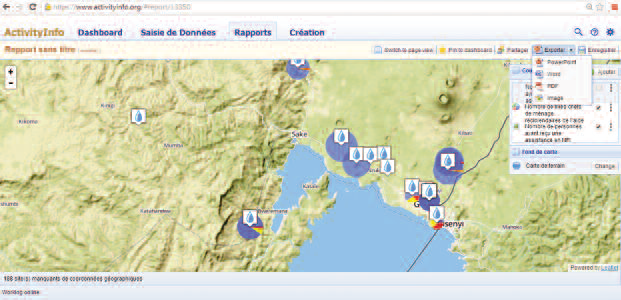Spreading around the globe: ActivityInfo
 By Claire Barnhoorn
By Claire Barnhoorn
Claire Barnhoorn is a graduate from the NOHA MSc Humanitarian Assistance (UCD, Dublin) and currently working at MSF. Besides a long standing interest in (technical) innovations within humanitarian aid, she is passionate about data, measurable M&E and informed decision-making. Previously she was the project leader of ActivityInfo, assisting organisations to operationalise ActivityInfo and in 2012, worked as a UNICEF-Mali consultant to lead the roll out of AcitivityInfo for the emergency response.
 Location: Global
Location: Global
What we know: Sharing programme data and analyses takes considerable time and resources in humanitarian operations and is complicated. Practical constraints include lack of harmonised units of measure between programmes, multiple data submissions to different users (internal use, sectoral coordinators, donors) and incompatible worksheets.
What this article adds: ActivityInfo is an online/offline, browser-based humanitarian project management and monitoring tool, licensed as open source software. It was developed at field level to simplify reporting and allow for real time monitoring. Its use has spread by ‘word of mouth’ from DRC to Mali, Somalia, Madagascar, South Sudan, Jordan and Lebanon. See: www.activityinfo.org.



Sharing information on activities is a challenge for many among us working in humanitarian aid. Current systems of storing and sharing information are often resource intensive (in terms of time and money) and lead to sub-optimal outcomes in the quality of our programming as a result of data loss, lack of information shared and lack of analysis. Ask any humanitarian programme manager how many hours are spent on reporting, meetings and requests for programme information and the answer will probably easily exceed half of our working hours. Hours not counted are those spent in frustration at incompatible excel sheets, lost macros or different unit of measures when aggregating data. On entering cluster meetings, agency representatives working in humanitarian emergencies often start by calling out numbers, toilets build, MAM/SAM cases admitted, kits distributed or cholera cases found. Hours pass before being able to really analyse the needs, appropriateness of the response and being able to plan for activities. Another great difficulty often encountered with data is ‘the unit of measure’ since not all involved in a humanitarian response are using the same definition. For example, you can find that one organisation reports toilets being built by block while another organisation reports toilets by door, creating a tough job for information management officers.
The need
In late 2008, UNICEF’s Emergency Unit in the Democratic Republic Congo (DRC) faced the challenges of coordinating two large multi-year, multi-partner programmes. These were the Programme for Expanded Assistance to Returnees (PEAR) and the Rapid Response Mechanism (RRM) which merged into the RRMP (Response Rapide de Movement des Populations)1. UNICEF’s Emergency Unit in the DRC started to work with an information management consultant to address the issues and challenges faced by developing a field-driven tool for monitoring and evaluation (M&E). The requirements were shaped by organisations working within RRM and PEAR and were tested through the assignment. Realising that building another excel-based datasheet was not going to solve the real issues, the idea of a new field-driven tool called ActivityInfo was born. From the start, ActivityInfo was built as an open source solution (under GPL (General Public Licence), making it possible for the wider humanitarian world to benefit in the future. Furthermore, the software can be adapted and developed as needed.
Development
The first version of ActivityInfo was developed between January and March 2009, and evolved monthly through 2009 in response to user feedback and emerging operational needs. In late 2009, ActivityInfo was adopted as the Non-Food Items (NFI) and Education Clusters’ information management platform in the DRC and in 2010, OCHA began expanding ActivityInfo’s use to the remaining clusters there.
Because ActivityInfo’s developers were based in eastern DRC throughout 2009, the application has been built from ‘the ground up’, to function well in the most challenging of environments. It is optimised for latency-satellite connections and ready for chaotic IT environments with support for all browsers, and works both on- and off-line. ActivityInfo databases can be created for a project, a mission, a cluster, an operational coordination centre, etc, with different indicator-based activities and enables monitoring at every level. Database rights can be allocated to specific users with separate logins. Data need only be entered once, since they can be exported to other databases (e.g. to the cluster or funding agency). Development and evolution continues, for example, in 2013 there was an integration with ODK (OpenData Kit), following a growing number of organisations in aid using ODK. ActivityInfo also strengthens data security as the data are not stored within separate datasheets (Excel files etc.) on local computers.
Spreading the word
ActivityInfo is now used by more than 300 people from 75 different organisations in the DRC alone, from local Congolese NGOs to large international non-governmental organisations (NGOs) and United Nations (UN) agencies. It has helped many organisations improve decision making by ensuring availability of the most recent data, chronologically and geographically, as well as disaggregated by partner, programme or any possible combinations of these. However there has been limited PR or communication carried out by the company behind ActivityInfo; the experiences of individuals and organisations are the driving force behind the growth in its use. Staff turnover and rotating rosters of organisations result in the spread of ActivityInfo, with individuals starting to take the tool with them to be implemented in other settings. As an example of this, by 2012 ActivityInfo was rolled out in Mali’s emergency response by UNICEF. This was followed by a request from Madagascar for the tool to be used in the cyclone response. In 2013, both UNHCR and UNICEF used ActivityInfo as their information management system in the Syria response, operating from Jordan and Lebanon, as well as a roll out for UNMISS2 starting in South Sudan. UNHCR has currently its own ActivityInfo portal in Jordan3, serving as a platform for approximately 300 organisations to better centralise, map and analyse humanitarian activities. International NGOs are also taking on ActivityInfo, e.g. Mercy Corps has been using ActivityInfo for some years in Somalia. Small local NGOs are also benefiting and enjoying functions, such as being able to produce quality maps without Geographic Information Systems(GIS) expertise and sending out automated custom made reports with graphs and tables using real time information.
ActivityInfo helps lower the burden of reporting and improves informed decision making and programming. There has been little research conducted so far on ActivityInfo and its impact on monitoring and ultimately on humanitarian responses, since it has been operating under the
radar for most of us, while being developed in field offices. The year 2014 will mark the 5th anniversary of ActivityInfo and might mark a change in this with the recent rapid escalation in its use following its roll out in large emergencies (Syria and South Sudan).
For more information, contact Claire Barnhoorn: email: cmbarnhoorn@gmail.com or BeDataDriven, the company which developed ActivityInfo: email: activityinfo@bedatadriven.com http://bedatadriven.com/
2United Nations Mission in the Republic of South Sudan
3Syrian Refugee Response Tracking: http://www.syrianrefugeeresponse.org/

